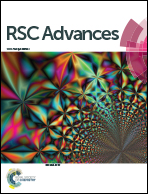Palladium-catalyzed carbonylation of aryl halides: an efficient, heterogeneous and phosphine-free catalytic system for aminocarbonylation and alkoxycarbonylation employing Mo(CO)6 as a solid carbon monoxide source†
Abstract
Immobilized palladium metal-containing magnetic nanoparticles (ImmPd(0)-MNPs) were synthesized and characterized as an immobilized, phosphine-free catalyst for carbonylation reactions, namely the alkoxycarbonylation and aminocarbonylation reactions. Various substituted aryl iodides tolerated the reaction conditions and a wide variety of alcohols and amines were used efficiently. The effects of the solvent, base, and temperature were studied in both the mentioned reactions. The developed catalytic system avoids the use of phosphine ligands and can be reused for up to eight consecutive cycles. The recycled catalyst was characterized by TEM and ICP analysis.


 Please wait while we load your content...
Please wait while we load your content...